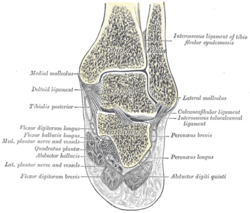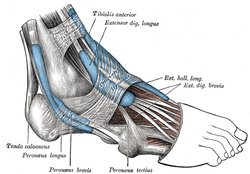Peroneus brevis
| Fibularis brevis muscle | |
|---|---|

Coronal section through right talocrural and talocalcaneal joints. (Label for Peroneus brevis is at right, third from the bottom.)
|
|

The mucous sheaths of the tendons around the ankle. Lateral aspect. (Peroneus brevis labeled at bottom left.)
|
|
| Details | |
| Origin | Lower two-thirds of lateral fibula |
| Insertion | Fifth metatarsal |
| Artery | Fibular artery (peroneal artery) |
| Nerve | Superficial fibular nerve |
| Actions | Plantarflexion, eversion |
| Identifiers | |
| Latin | Musculus fibularis brevis, musculus peronaeus brevis |
| Dorlands /Elsevier |
m_22/12546596 |
| TA | A04.7.02.042 |
| FMA | 22540 |
|
Anatomical terms of muscle
[]
|
|
The fibularis brevis muscle (or peroneus brevis) lies under cover of the fibularis longus, and is a shorter and smaller muscle.
It arises from the lower two-thirds of the lateral surface of the body of the fibula, medial to the peroneus longus, and from the intermuscular septa separating it from the adjacent muscles on the front and back of the leg.
The fibers pass vertically downward, and end in a tendon which runs behind the lateral malleolus along with but in front of that of the preceding muscle, the two tendons being enclosed in the same compartment and lubricated by a common mucous sheath.
It then runs forward on the lateral side of the calcaneus, above the calcaneal tubercle and the tendon of the peroneus longus, and is inserted into the tuberosity at the base of the fifth metatarsal bone, on its lateral side. When the base of the fifth metatarsal is fractured, the peroneus brevis may pull on and displace the proximal fragment (Jones Fracture). An inversion sprain of the foot may pull the tendon such that it avulses the tuberosity at the base of the fifth metatarsal.
It is also innervated by the superficial fibular (peroneal) nerve.
The muscle assists in weak plantarflexion and eversion of the foot.
The terms "Peroneal" (i.e., Artery, Retinaculum) and "Peroneus" (i.e., Longus and Brevis) are derived from the Greek word Perone (pronounced Pair-uh-knee) meaning pin of a brooch or a buckle. In medical terminology, both terms refer to being of or relating to the fibula or to the outer portion of the leg.
Bones of the right leg. Anterior surface.
Bones of the right foot. Dorsal surface.
Muscles of the front of the leg.
Cross-section through middle of leg.
The popliteal, posterior tibial, and fibular arteries.
Back of left lower extremity.
Fibularis brevis muscle
...
Wikipedia
